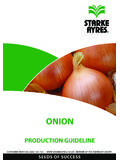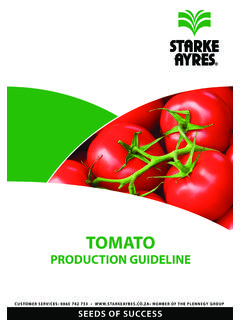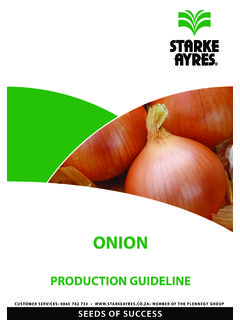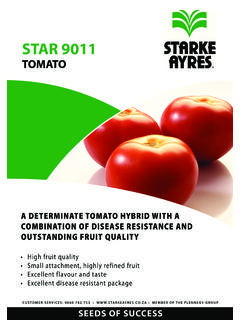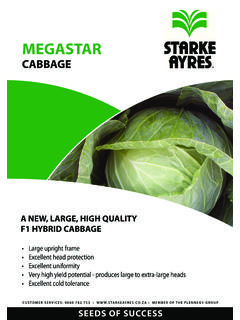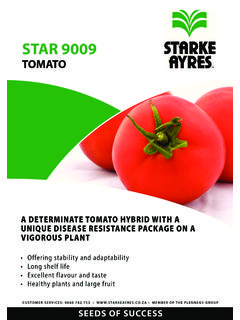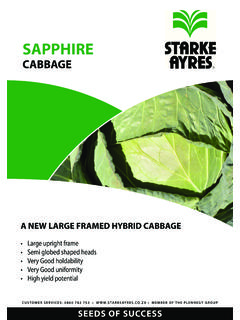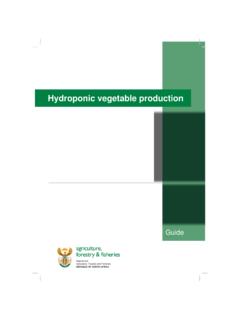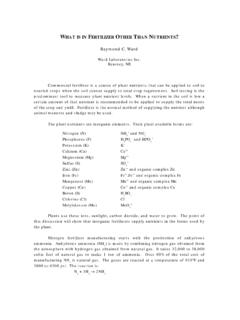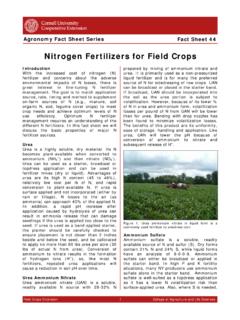Transcription of Table of Contents - Starke Ayres
1 Table of Contents GARDEN ACID LOVING PLANT FLOWERING GROWING HYDRANGEA IRON organic PALM PLANT FOOD ROSE SEA SERADIX GARDEN FERTILISERS 1. INTRODUCTION A fertilizer can be defined as :- Any organic or inorganic substance, containing one or more plant nutrients in sufficient quantities and which is intended, or offered to be used for improving or maintaining the growth of plants, or the fertility of the soil. An inorganic fertilizer is :- A chemically composed substance, which contains one or more of the plant nutrients Nitrogen (N), Phosphorus (P) or Potassium (K); and that it shall not contain any substance or substances that can be considered harmful to man, animal, plant or the environment; and that all other macro-elements that it may contain in registerable quantities, shall be registered.
2 An organic fertilizer is :- A fertilizer made of substances, of animal or plant origin, or a mixture of such substances and which is free of any compounds that could be harmful to man, animal, plant or the environment. An organic fertilizer mixture is :- A mixture of registered organic fertilizers and registered inorganic fertilizers and which contains at least 200g/kg and a maximum of 500g/kg organic fertilizers, but excluding urea. The term enrich can be described as :- The edition of registered inorganic fertilizers to registered organic fertilizers in order to enhance the plant nutrient content of the organic fertilizer (total content minimum 100g/kg) ( organic content must be 500g/kg).
3 Compost can be described as :- A stable homogenous, completely decomposed material of animal or plant origin and to which no plant nutrient has been added (free of). All plants require certain nutrients, which can be grouped into three categories according to importance, for normal growth and production. Fertilizers are formulated to contain nutrients in varying strengths and combinations, to replace those lost to leaching and by plant uptake. MAJOR PLANT NUTRIENTS LARGE AMOUNTS REQUIRED Macro element Plant requirement Nitrogen (N) Promotes healthy leaves and shoots. Moves quickly into the soil The leaf maker.
4 Phosphorus (P) Promotes strong healthy root growth and fruit development (maturation). Moves slowly through the soil, especially in areas , which do not have a high rainfall The root maker. Potassium (K) For general plant health, disease resistance and healthy fruit production. Important for root and tuber crops, tomatoes, flowering plants and fruits. Aids the absorption of nitrogen and phosphorus. Increases the plants resistance to disease The flower and fruit maker. INTERMEDIATE PLANT NUTRIENTS MODERATE AMOUNTS REQUIRED Calcium (Ca) For plant growth of fruit, flowers and vegetables, particularly in acid and potassium rich soils.
5 Magnesium (Mg) Promotes satisfactory plant growth, particularly in roses and tomatoes. Important component of chlorophyll, thus vital for photosynthesis. Helps to control enzyme operations. Sulphur (S) Promotes satisfactory plant growth in all plants. TRACE ELEMENTS SMALL AMOUNTS REQUIRED Iron (Fe) Valuable in poor soils, signs are yellowing of leaves. Produces chlorophyll and thus green leaves. Essential for photosynthesis and thus all growth. Manganese (Mn) Required for Azaleas, Camelias and Hydrangeas in poor soils. Molybdenum (Mo) Needed for sexual reproduction and development of embryos. Production of proteins and vitamins (Vit C) Increasing yield of crop Chlorophyll production and thus greening of leaves.
6 For correction of deficiencies in Brassicas (narrow leaves). Boron (B) For root growth of vegetables, particularly in sandy soils. Reproduction specially seed an fruit set. Disease resistance Zinc (Zn) Particularly for fruit and vegetables in sandy soils. Copper (Cu) Fruit and vegetables in sandy soils. Fertilizers sold in the Republic must comply with the Fertilizers, Farm Feeds, Agricultural Remedies and Stock Remedies Act, 1947. (Act No. 36 of 1947). Fertilizers, where applicable must also comply with the requirements of the Explosives Act, 1956. (Act No. 26 of 1956). Fertilizers can be presented as single elements of either Nitrogen (N) : Phosphorus (P) : Potassium (K) single element fertilizer, or as a blended combination of two to three of the elements balanced fertilizer mixture.
7 2. TYPES OF FERTILIZERS Fertilizers are sold in numerous forms. Certain presentations are available as Home Garden Fertilizers, these can be roughly categorized as follows :-- Granulated Refers to the structure of the fertilizer, hard granules of between 1 4 mm (average 3 mm) in size and includes single element/s and mixtures of both inorganic and organic types, although mainly inorganic. Concentrates Are generally water soluble, balanced inorganic mixtures, which can include trace elements. Liquids Single element, or balanced concentrated mixtures, that are normally diluted in water.
8 Can be inorganic or organic , or a combination of both. Other Powders, smaller than 1 mm in size. - Growth stimulants, growth regulators, growth hormones and trace element (micro element) mixtures. - Compost and other organic presentations such as peat and growing mediums. - Soil conditioners or enhancers. - The fertilizer type must appear on all packaging as full description, or in an abbreviated form, as follows :- Korrel / Granule G / R Makro Korrel / Macro Granule SK /SG Mini Korrel / Mini Granule MK / MG Poeier / Powder P Kristal / Crystal C Suspensie / Suspension SP Oplossing / Solution OPL / SOL Lae Chloor / Chlorine low Cl laag / Cl low 3.
9 FERTILIZER FORM The nutrient content of a registered fertilizer must be shown using a specific sequence of numbers, which corresponds to the macro elements This sequence of numbers ( ) is followed by a bracketed number, 2:3:2[22], which shows the total amount [or total percentage] of fertilizer [nutrients] in the product. Using 2:3:2[22] as an example :- 22% of the total Contents is fertilizer, the balance of [78%] is an inert carrier, necessary to allow controlled application. Fertilizer content of 22% is divided into 2 parts Nitrogen : 3 parts Phosphorus : 2 parts Potassium (of the 22%).
10 Percentage can be established thus :- - Total (Nitrogen + Phosphorus + Potassium) 2 + 3 + 2 - = 7 - Nitrogen - 22 7 x 2 = = - Phosphorus - 22 7 x 3 = = - Potassium - 22 7 x 2 = = Calcium [Ca] : Magnesium [Mg] : Sulphur [S] percentage content are also indicated, when applicable. Trace elements, when applicable, are also included and apply mainly to concentrates. The action of fertilizers can vary according to their origin and formulation Chemical or inorganic fertilizers are normally dissolved quickly and can be regarded as quick acting, particularly liquid formulations.
